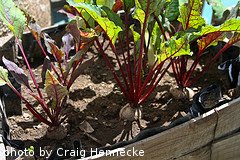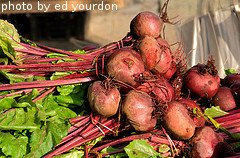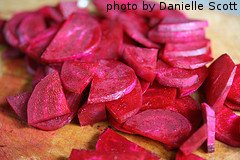Want To Learn About Growing Beets?
One of the advantages of growing beets is that they provide two different food sources; you can eat both the tops and the roots. The tops can be eaten raw in salads or steamed, sauteed or braised. The roots can be eaten raw, pickled, roasted, boiled or steamed. In addition, red beet juice has been used for centuries as a dye. There are also varieties of sugar beets, which can be made into syrup and even sugar. Beets are a great source of vitamin C, potassium, folate and dietary fiber.

Beets are easy to grow and they don't take up much space in the garden. They are a cool season crop that grow best when daytime high temps are 60-70 degrees F. The seeds will germinate when soil temps are 55-75 degrees F. In many areas, beets can be grown as both a spring and fall crop. In milder climates, beets are often grown in the spring for their tops and in the fall for their roots. Beet roots tend to get sweeter if they are left in the ground at least until after the first frost in the fall. Beets require lots of sun and should be planted in well-tilled soil that drains well. They are also suitable for container gardening. They mature quickly, usually in 50-70 days, depending on the variety. This makes beets a great choice for a kid's garden.
Marcus remembers picking beets from his grandmother's garden when he was just a few years old. Back then, he wasn't too keen on eating them. However, he did like that when he handled them after they were cut up, they stained his hands a dark red color. Nowadays, it's actually the opposite - he likes to eat both the roots and tops, but he's not happy when they stain his hands. If you have a lot of beets to process, we recommend wearing rubber gloves.

Since beets are root vegetables, it's important to work the soil deeply enough to allow the roots to reach their potential. We like to use the raised row method when growing beets, and this works well to give the beets plenty of room. After we till our garden, we use a shovel to create raised rows that are about 8 inches tall and 1 foot across for the length of the row. The raised rows help with drainage and also provide loose, airy soil so the beet roots can reach their maximum size. In addition, we don't have to bend over quite so far to weed or harvest when we plant them in raised rows.
There are several different beet varieties available to the backyard vegetable gardener. Some folks grow beets just for the tops, others are looking for nice-sized roots. We like to use both parts of the plant. Beets come in lots of different sizes and shapes. Some sugar beets can weigh 15 pounds or more. There are several colors of beet roots that include red, purple, striped, white and golden yellow. The tops are often a mix of green, purple and sometimes red.
When choosing a beet variety to grow, think about what you want to use the beets for. Some varieties produce much larger roots than others, while other varieties produce much larger and tender tops. Also, if you're interested in long term storage of beets, research which varieties store better. In our own garden, we like to plant a few different beet varieties - one for the tops, one for the roots and 1-2 unique varieties that produce unusual colors and shapes. We don't typically store beets in our root cellar, preferring to can them instead. This way, we only have to heat them up before we eat them. However, many beet varieties will keep whole for up to 3 months in a cool, dark place.
Here's some different varieties of beet seeds if you're interested...
Quick Overview of Growing Beets
Planting: Plant seeds 1/2 inch deep when soil temps have warmed to at least 55 degrees F, scatter seeds every 2 inches in rows spaced 1 foot apart.
Fertilizing: Use fertilizer with more phosphate and potassium and less nitrogen, apply to soil before planting, can use water soluble fertilizer when seedlings appear.
Watering: Keep soil evenly moist, but not wet.
Harvesting: Pick for tops when they reach desired size, pick roots when tops start to wilt.
Recipes: After you're done growing beets, they can be boiled, roasted, smoked, fried, sauteed or pickled.

Click on the following links to learn more about growing beets...
Click here to learn about planting beets
Click here for information about fertilizing and watering beets
Click here to learn about harvesting beets
Click here for information about different beet varieties
Click here for some of our favorite beet recipes
Click here to move from our Growing Beets page to our Home page